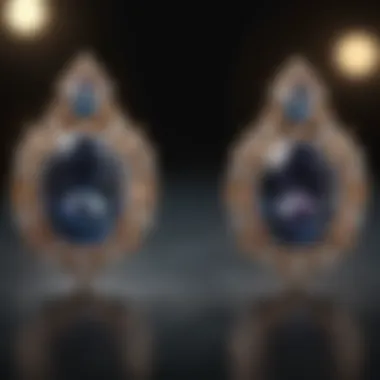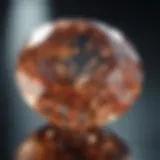Unlocking the Meaning Behind Carat Weight in Jewelry: Decoding 'CTS'


Overview of Gemstones and Minerals
In the vast universe of jewelry, gemstones and minerals play a pivotal role. Their history traces back centuries, where they were cherished and revered for their beauty and rarity. The significance of gemstones and minerals extends beyond mere ornaments; they hold cultural and societal importance, symbolizing wealth, power, and tradition. Throughout various civilizations, gemstones have been adored for their mystique, used as heirlooms, amulets, and expressions of status.
Gemstone Formation and Properties
Delving into the formation process of gemstones unveils a fascinating journey of nature's craftsmanship. From the depths of the earth, gemstones undergo a metamorphic transformation, where immense pressure and heat converge to create these stunning marvels. The properties that define gemstones are manifold, ranging from color, hardness, refractive index, to cleavage and specific gravity. These intrinsic characteristics not only differentiate one gemstone from another but also contribute to their uniqueness and allure. Classification based on color, hardness, and luster aids gemologists in identifying and categorizing these precious gems.
Types of Gemstones
Within the realm of gemstones, a distinction exists between precious and semi-precious varieties. Precious gemstones such as diamonds, rubies, sapphires, and emeralds command attention for their rarity and exceptional beauty. On the other hand, semi-precious gems like amethyst, aquamarine, and garnet exude their charm and elegance in a more subtle manner. Exploring common gemstone varieties illuminates a spectrum of colors, shapes, and sizes that cater to every preference. For the aficionados of the exotic and rare, gemstones like tanzanite, alexandrite, and paraiba tourmaline offer a glimpse into the enchanting world of exclusive gem treasures.
Identifying and Evaluating Gemstones
Ascertaining the value of gemstones involves considering various factors that impact their worth. From color intensity and clarity to cut precision and carat weight, each element plays a pivotal role in determining a gemstone's value and desirability. Techniques for gemstone identification require expertise and precision, combining gemological tools, such as loupes, microscopes, and refractometers, to evaluate authenticity and quality. Assessing gemstone quality involves a meticulous appraisal of factors like color consistency, inclusions, and brilliance, which collectively contribute to the gem's overall appeal and market value.
Caring for Gemstones
Ensuring the longevity and luster of gemstones necessitates proper care and maintenance. Cleaning and storing gemstones correctly preserve their beauty and integrity, preventing scratches, dullness, or damage. Avoiding common mistakes in gemstone care, such as exposure to harsh chemicals, extreme temperatures, or rough surfaces, safeguards their longevity and brilliance. Preservation tips for specific gem types cater to the unique requirements of each gemstone, offering insights into enhancing their longevity and sheen for generations to come.
Introduction
The world of jewelry holds within each piece a story, a journey of craftsmanship and elegance. Add to this equation the enigmatic 'CTS,' a term that carries weight, pun intended, in the gemstone industry. As we embark on deciphering the meaning of 'CTS' in jewelry, we peel back the layers of mystique that surround this term, revealing its profound significance in assessing the value and quality of gemstone pieces. Our exploration will not only shed light on the technical aspects of carat weight measurement but also unveil the subtle nuances that make 'CTS' a pivotal factor for gemstone enthusiasts, collectors, jewelry designers, and geology enthusiasts alike.
To comprehend 'CTS' fully, we must first delve into the fundamentals of carat weight measurement. By uncovering the origins of carat measurement and dissecting its definition, we set the stage for a thorough examination of how this unit of measurement influences the gemstone industry. From exploring the impact of carat weight on gemstone value to understanding its relationship with gemstone size, each facet adds a layer of complexity to the narrative, enriching our understanding of why 'CTS' matters in the world of jewelry.
Moving beyond the surface, our journey takes us deeper into the realm of precision and accuracy in carat measurement. We enlighten ourselves on the tools and techniques used to determine carat weight, demystifying the processes that ensure consistency and reliability in this aspect of jewelry assessment. Furthermore, we delve into the role played by certification agencies, illuminating how their certifications authenticate the 'CTS' values assigned to gemstones, providing consumers with confidence in their purchases.
As we unravel the mysteries of 'CTS' in jewelry, we find ourselves at a crossroads of discernment. The implications for gemstone buyers become more apparent as we assess the quality and value associated with 'CTS.' Factors affecting 'CTS' in different gems come into play, influencing buying decisions and shaping the preferences of those seeking the perfect gemstone piece. Navigating 'CTS' in gemstone selection requires a delicate balance, one that involves choosing the right combination of carat weight while considering other essential factors that define a gemstone's allure.
In the vast landscape of jewelry, 'CTS' stands as a beacon of distinction, guiding gemstone enthusiasts towards making informed choices. Our exploration will equip readers with the knowledge and insight needed to evaluate 'CTS' in jewelry pieces, offering practical tips for assessing gemstone certificates and comparing 'CTS' values across various jewelry items. By focusing on ensuring transparency in 'CTS' disclosure, we uphold industry standards and regulations, safeguarding consumers from misleading practices that blur the lines between authenticity and deceit.
Understanding Carat Weight Measurement


Carat weight measurement plays a pivotal role in the assessment and valuation of gemstones, serving as a fundamental metric in the jewelry industry's hierarchy of criteria. The significance of understanding carat weight lies in its direct correlation with the perception of a gemstone's value and quality. By delving into this aspect, individuals can develop a nuanced understanding of how carat weight impacts the overall allure of a gemstone. Furthermore, comprehending carat weight allows consumers to make informed decisions when acquiring gemstone jewelry pieces and navigating the complexities of the market.
Exploring the Basics of Carat Weight
Definition of Carat
When dissecting the essence of a carat, we encounter a unit of measurement synonymous with evaluating the mass of gemstones. The fundamental importance of the definition of a carat is the universal understanding it provides across the gemstone industry. This standardized unit allows for streamlined comparisons and assessments of gemstones, ensuring consistency and accuracy in transactions and appraisals. While the definition of a carat may seem straightforward, its implications transcend mere numerical value, reflecting a gemstone's inherent rarity and desirability.
Origins of Carat Measurement
The origins of carat measurement trace back to ancient civilizations where seeds were initially used to weigh precious stones. Over time, the evolution of carat measurement led to the establishment of the modern metric for gemstone evaluation. The key feature of the origins of carat measurement lies in its historical significance, underlining the enduring legacy of gemstone assessment practices. While the ancient methods may seem rudimentary compared to contemporary techniques, they laid the foundation for the intricate systems in place today, showcasing the evolution of gemstone valuation methods.
Significance of Carat Weight in Gemstones
Impact on Gemstone Value
The impact of carat weight on gemstone value is a crucial determinant in the pricing and appraisal of gemstones. Larger carat weights often translate to heightened values, reflecting the rarity and desirability of sizable gemstones. Understanding this aspect empowers gemstone enthusiasts to gauge the worth of their acquisitions accurately and appreciate the correlation between size and value. However, it is essential to note that other factors also influence gemstone valuation, emphasizing the multifaceted nature of assessing a gemstone's worth.
Relationship with Gemstone Size
The relationship between carat weight and gemstone size sheds light on the intricate balance between mass and dimensions. While a higher carat weight typically corresponds to larger gemstone sizes, variations exist due to differences in density and cut styles. This dynamic interplay underscores the importance of considering both carat weight and size when evaluating gemstones. By navigating this relationship, individuals can make informed decisions regarding gemstone purchases, ensuring a harmonious blend of size and weight in their jewelry.
Precision and Accuracy in Carat Measurement
Tools and Techniques Used
The tools and techniques employed in carat measurement underscore the commitment to precision and accuracy within the gemstone industry. Ranging from digital scales to spectroscopic analyses, these methods ensure reliable assessments of gemstone weight. The key characteristic of these tools lies in their ability to detect subtle variations in weight, facilitating precise measurements crucial for valuation purposes. While technological advancements have enhanced measurement accuracy, traditional techniques continue to hold value, symbolizing the coexistence of innovation and heritage in the gemstone trade.
Role of Certification Agencies
Certification agencies play a critical role in validating the accuracy of carat measurements and providing assurances to consumers. By entrusting certified professionals with the task of appraising gemstones, buyers can make informed decisions based on authenticated information. The unique feature of certification agencies lies in their unbiased evaluations, offering a standardized approach to gemstone assessment. However, it is imperative for consumers to verify the credentials of certification agencies to ensure transparency and credibility in the gemstone purchasing process.
Deciphering 'CTS' in Jewelry


In the section dedicated to Deciphering 'CTS' in Jewelry, we delve into the intricacies of this topic within the realm of jewelry. The significance of understanding 'CTS' lies in its crucial role in determining the value and quality of gemstone pieces in the market. By comprehending 'CTS,' enthusiasts and collectors can make informed decisions when it comes to selecting gemstone jewelry. Exploring 'CTS' offers a unique perspective on the complexity and precision involved in gemstone evaluation and acquisition, making it a valuable addition to this article aimed at shedding light on the nuances of carat weight measurement in jewelry.
Meaning and Interpretation of 'CTS'
Common Usage in Jewelry
When dissecting the common usage of 'CTS' in jewelry, we uncover the fundamental aspect of how carat total weight impacts the overall value and appeal of gemstone ornaments. In this article, the emphasis on 'CTS' serves to educate readers on the prevalent practice of evaluating gemstones based on their total carat weight, providing a comprehensive understanding of the key factors influencing gemstone pricing and desirability. The unique selling point of 'CTS' lies in its direct correlation with gemstone value, making it an indispensable metric for both buyers and sellers in the jewelry industry.
Understanding Carat Total Weight
Within the context of Understanding Carat Total Weight, we highlight the meticulous process of calculating and interpreting the total carat weight of gemstones. This segment underscores the importance of accuracy and precision in determining the combined weight of multiple gemstones within a piece of jewelry. By elucidating the nuances of carat total weight, this article aims to equip readers with the knowledge necessary to differentiate between various gemstone compositions and make informed purchase decisions. Understanding the mechanics of carat total weight contributes significantly to the overall theme of elucidating the role of 'CTS' in jewelry.
Implications for Gemstone Buyers
Assessing Quality and Value
When considering the implications of 'CTS' for gemstone buyers, the focal point rests on how carat total weight influences the perceived quality and value of gemstones. By evaluating gemstones based on their 'CTS,' buyers can gauge the intrinsic worth of a piece of jewelry and make informed investment decisions. This article sheds light on the significance of 'CTS' in demystifying the valuation process for gemstone enthusiasts, providing essential insights into the factors that determine a gemstone's quality and monetary value.
Factors Affecting 'CTS' in Different Gems
In exploring the factors affecting 'CTS' in different gems, we uncover a multifaceted landscape of variables that impact the total carat weight of gemstones. Understanding how various factors such as gem type, cutting style, and clarity levels contribute to 'CTS' is essential for both novice and seasoned buyers. By dissecting these elements, this article offers a comprehensive overview of the nuanced considerations that influence the final 'CTS' of a gemstone, providing valuable knowledge for buyers navigating the intricate world of gemstone selection.
Navigating 'CTS' in Gemstone Selection
Choosing the Right Balance
When discussing the importance of choosing the right balance in gemstone selection, we address the delicate equilibrium between carat total weight and other quality indicators. Selecting the appropriate balance ensures that buyers make well-informed choices when purchasing gemstone jewelry, considering factors beyond just 'CTS.' By elucidating the significance of striking a balance in gemstone selection, this article underscores the importance of a holistic approach to evaluating gemstone pieces, guiding enthusiasts towards making astute purchasing decisions.
Balancing 'CTS' with Other Factors
Within the realm of balancing 'CTS' with other factors, we navigate the complex interplay between carat total weight and various quality attributes that define the allure of a gemstone. By examining how 'CTS' interacts with considerations such as color, clarity, and cut, buyers gain valuable insights into optimizing their selections based on a comprehensive appraisal of gemstone characteristics. This section serves as a guide for discerning buyers looking to balance 'CTS' with other critical factors in their quest for exquisite gemstone jewelry.
Practical Applications and Considerations


Carat Total Weight (CTS) in jewelry holds substantial importance within the gemstone industry. Understanding the practical applications of CTS involves examining gemstone certificates and comparing CTS across different jewelry pieces. Evaluating CTS in jewelry pieces is crucial for buyers and collectors alike to ensure they are getting authentic and high-quality gemstones. By thoroughly examining gemstone certificates, one can verify the accuracy of CTS stated, guaranteeing transparency and authenticity in the purchase. Additionally, comparing CTS across various pieces allows for a better understanding of the value and quality differences between gemstones.
Tips for Evaluating 'CTS' in Jewelry
Examining Gemstone Certificates
Examining gemstone certificates is a paramount aspect of evaluating CTS in jewelry. These certificates provide essential information about the gemstone, including carat weight, cut, clarity, and color. By scrutinizing these certificates, buyers can verify the accuracy of the stated CTS, ensuring they are investing in genuine gemstones of the specified weight. This meticulous examination of certificates enhances transparency and trust between buyers and sellers, promoting informed decisions.
Comparing 'CTS' Across Jewelry Pieces
Comparing CTS across different jewelry pieces allows buyers to assess value and quality variations. By comparing the CTS of similar gemstones in various settings, individuals can gauge the impact of factors like design, craftsmanship, and additional gemstone embellishments on the overall carat weight. This comparative analysis enables buyers to make educated choices based on their preferences and priorities, whether focusing on gemstone size or intricate jewelry design.
Ensuring Transparency in 'CTS' Disclosure
Industry Standards and Regulations
Adhering to industry standards and regulations plays a pivotal role in ensuring transparency in CTS disclosure. Complying with established guidelines set by gemological institutes and regulatory bodies helps maintain consistency and reliability in disclosing carat weights. By following these standards, jewelers and gemstone sellers uphold credibility and professionalism, fostering trust and confidence among consumers.
Avoiding Miselading Practices
Avoiding misleading practices in CTS disclosure is essential for maintaining integrity within the gemstone industry. By refraining from deceptive tactics such as misrepresenting carat weights or using unclear terminology, sellers uphold ethical standards and preserve credibility. Transparency in CTS disclosure not only protects consumers from deceptive practices but also promotes a fair and honest marketplace environment.
Future Trends in Carat Weight Measurement
Technological Advancements
Technological advancements are revolutionizing carat weight measurement in the gemstone industry. From advanced weighing devices to digital imaging systems, technology contributes to more accurate and precise weight verification of gemstones. These innovations streamline the evaluation process, offering enhanced efficiency and reliability in determining carat weights. Embracing technological advancements ensures progress and accuracy in carat weight measurement, marking a significant shift in the gemstone industry.
Innovations in Weight Verification
Innovations in weight verification are reshaping the gemstone market's approach to measuring carat weight. Through methods like laser scanning and spectroscopy, gemologists can now assess carat weights with unprecedented accuracy and detail. These innovations not only enhance the verification process but also provide insights into gemstone composition and quality. By adopting innovative weight verification techniques, stakeholders in the gemstone industry promote advanced practices and elevate standards of precision in carat weight measurement.
Conclusion
Deciphering the meaning of 'CTS' in jewelry is pivotal for anyone involved in the gemstone industry. The understanding of 'Carat Total Weight' goes beyond just numbers; it encapsulates the essence of value, quality, and precision within each gemstone piece. By grasping the implications of 'CTS,' buyers can make informed decisions, ensuring they acquire not just a gemstone, but a symbol of craftsmanship and authenticity. Moreover, for gemstone enthusiasts and collectors, navigating 'CTS' adds a layer of sophistication and discernment to their passion.
The multifaceted nature of 'CTS' in gemstone selection is a testament to the intricate world of jewelry craftsmanship. Gemstone designers and artisans shift not only through carat weight but also through artistic vision, interpreting 'CTS' as a canvas for creativity and expression. The significance of 'CTS' in jewelry design transcends mere numbers on a scale; it embodies a story, a legacy, and a timeless piece of art that reflects the journey of each gemstone from earth to embellishment.
For geology enthusiasts, understanding 'CTS' bridges the gap between scientific precision and aesthetic beauty. By delving into the nuances of carat weight measurement, they unravel the geological processes that culminate in breathtaking gemstones. 'CTS' becomes a language that speaks of the earth's treasures, the pressures of time, and the artistry of nature distilled into magnificent gemstone creations.







